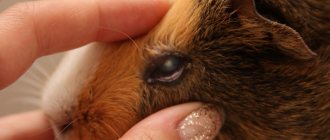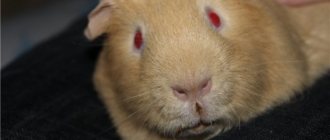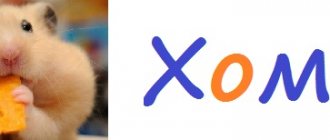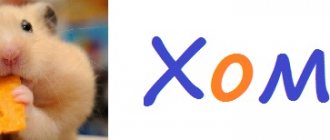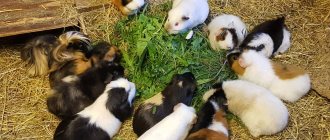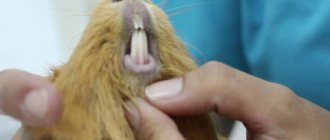Eye diseases appear quite often in guinea pigs. The reason is the lack of protection for the visual organs. They lack nictitating membranes, which makes them open to germs, bacteria, and foreign particles. Many owners, having discovered signs of pathologies, use drugs from their first aid kit in treatment. The consequence of this approach in most cases is deterioration of the condition, decreased visual acuity, blindness, and death is not excluded. It is necessary to know what eye diseases can appear in a guinea pig, the causes of diseases and methods of treating them.
Conjunctivitis
The inflammatory process of the mucous membrane of the eye is called conjunctivitis.
Important! You can independently determine if your rodent has health problems. But to be more reliable, it is better to seek help from a veterinarian.
There are many reasons for the development of this disease:
- eyeball injuries;
- entry of foreign bodies;
- allergic reaction (to dust, smoke, etc.);
- lack of vitamin C in the body;
- infectious pathologies.
Signs of conjunctivitis are as follows:
- the eye begins to water;
- weakness appears;
- eyelids may swell;
- the mucous membrane turns red;
- loss of appetite;
- purulent blisters appear in the eye area.
This disease can be treated in several ways:
- Clean your eyes from discharge three times a day with a gauze swab dipped in boiled water.
- Instill medications with anti-inflammatory properties. The best option is “Tsiprovet” or “Iris”.
- Use special vitamins.
- Rinse your eyes with saline solution.
Try not to use traditional medicine without a doctor's prescription. Veterinarians often prescribe antibiotics and antifungal drugs based on the animal’s well-being.
Did you know? Guinea pigs tend to eat their own droppings. This is because they absorb vitamin K during the second passage of food through the esophagus.
Can a pig infect its owner with rabies?
Rabies is a disease that affects most animals and people. Thanks to vaccination, it is almost impossible to encounter animals infected with rabies in large cities and surrounding areas. But there is a possibility of infection from wild animals. The virus enters the body through the saliva of a sick animal. That is, for infection it is enough for contaminated saliva to come into contact with mucous membranes or damaged skin surfaces.
Guinea pigs are susceptible to many diseases. To protect your pet from illness, you need to take care of the animal, create the necessary conditions for its life and feed it properly. Regular care will allow you to identify the problem in time and take the necessary measures to cure your pet.
Fat eye
Very often you can notice that an animal develops an ophthalmological pathology - a fat eye. Symptoms of this disease include protrusion of the eye orbit. It is inherited and appears in young individuals, at the age of 6 months. Today, a medicine has not yet been invented to combat this disease . Therefore, in order to save the guinea pig’s vision, it will be necessary to perform laser plastic surgery of the conjunctival sac.
Video: Guinea pig has a fat eye
Eye diseases in guinea pigs
Not all, but most eye diseases in guinea pigs are accompanied by tearing and redness of the eyelids. Such symptoms indicate inflammation.
Conjunctivitis
Conjunctivitis in guinea pigs is the most common ophthalmological disease. The inflammatory process affects only the mucous membrane of the eyeball - the conjunctiva. The disease can affect one or both organs of vision.
Inflammation develops for several reasons:
- Due to pathogenic microorganisms that have entered the eye - fungi, bacteria or viruses.
- Against the background of allergies. Guinea pigs often have a reaction to the components of the litter, dust, tobacco smoke or cleaning and detergents.
The very first sign of conjunctivitis is that your pig's eyes are watery. Further, slight redness and swelling of the eyelids is observed. The rodent squints and rubs its muzzle with its paw, which only aggravates the problem. Then pus will appear. The discharge will become thicker and turn yellow. The eyelids will stick together. At this stage, the eyes are no longer watery, but the rodent experiences severe discomfort.
It is important to start treatment as quickly as possible. Ideally, the owner should react when the eyes just begin to water. Advanced conjunctivitis can lead to complications - inflammation of the cornea and even loss of vision.
Attention! Sometimes inflammation of the conjunctiva occurs against the background of deadly infectious diseases. The eyes of guinea pigs become watery and fester due to pasteurellosis. If, in addition to conjunctivitis, there is a runny nose, loss of appetite, depression and diarrhea, you should immediately put the animal in a separate cage and show it to a veterinarian.
Keratitis
This is an inflammation of the cornea (sclera) of the eye. Reasons for the development of keratitis:
- complication after untreated conjunctivitis;
- injury;
- entry of a foreign body;
- allergy.
Keratitis causes severe discomfort to the guinea pig. The affected eye is watery and painful. Because of this, the rodent constantly squints and rubs its muzzle with its paw. In bright light, the discomfort intensifies. The guinea pig becomes restless and loses its appetite.
If the inflammatory process affects the deeper layers of the cornea, scars will remain on it. This will lead to deterioration of vision or the appearance of a cataract.
Cataract
This is one of the most common causes of complete or partial loss of vision. In most cases, cataracts in guinea pigs develop at an advanced age. As the animal ages, the lens loses its properties and becomes cloudy. It can no longer perform its function of transmitting and refracting light.
Reference. With cataracts, the animal sees the image blurred, as if looking through a stream of water.
If cataracts are diagnosed in a young rodent, then its development is associated with other reasons:
- heredity;
- infectious diseases;
- eye injury;
- metabolic disorders.
With cataracts, the eyes do not water, the mumps does not have purulent discharge or discomfort.
At the early stage of the disease, the animal behaves as usual. An attentive owner may notice a slight change in the color of the lens around the perimeter. In this case, the rodent can freely navigate in space.
The disease gradually progresses, then cloudy spots appear in the central part of the lens. Now the animal sees only the outlines of objects. At the next stage, the entire biological lens becomes cloudy. Now the guinea pig is almost blind. She can only see light. At the final stage, the fibers of the lens begin to liquefy, after which it acquires a milky color.
Cataracts cannot be cured with medications. The only way to restore vision is surgery. However, such an expensive operation is almost never performed on guinea pigs.
Belmo
A cataract is a cloudy spot on the cornea of the eye, which usually appears at the site of a scar. In guinea pigs, it can form after an eye injury or any inflammatory processes that affect the cornea.
A guinea pig cataract looks almost exactly like a cataract. A cloudy porcelain-white spot appears on the eyeball. At the same time, the animal’s vision decreases.
Unlike cataracts, a cataract is accompanied by a burning sensation. The eyes water and the inside of the eyelid turns red.
If left untreated, the thorn will grow in size over time. This will lead to complete or partial loss of vision.
Fat eye
This is what people call prolapse of the conjunctival sac. This is a fatty fold under the eyelid that seems to run over the eyeball and can close part of the pupil. An oily eye does not water or hurt. This pathology does not pose any danger to the health of the guinea pig. However, fatty tissue may obscure the view.
In this case, the protruding fold is removed with a laser.
Important! Protrusion of fatty tissue from under the eyelid is inherited. Therefore, individuals with such a defect are not allowed for breeding. It is believed that cream and black guinea pigs are more susceptible to this pathology.
Glaucoma
This disease progresses rapidly and leads to complete blindness. Glaucoma is characterized by destruction of the retina as a result of increased eye pressure. The optic nerve gradually atrophies, so it cannot transmit signals to the brain. Glaucoma is more common in older guinea pigs.
Symptoms:
- swelling and redness of the cornea;
- watery eye;
- photophobia.
Glaucoma causes pain in the guinea pig's eye. The rodent develops anxiety, which intensifies in bright light. At the initial stage of the disease, you can get by with the use of drops that stabilize eye pressure. In advanced cases, you will have to resort to removing the organ of vision.
Retrobulbar abscess
With this disease, a cavity with pus forms in the retrobulbar space. An orbital abscess in a guinea pig can occur due to dental problems.
The clinical picture is as follows:
- swelling and hyperemia of the eyelids;
- exophthalmos;
- the eyeball partially loses mobility and protrudes greatly;
- the rodent looks lethargic;
- body temperature rises;
- When you open your mouth, the pain intensifies, so the animal squeaks.
Attention! The abscess can spontaneously open, then its contents will come out through the conjunctiva. However, there is a high probability of the abscess breaking inside. In this case, the development of phlegmon of the orbit of the eye, infection of the meninges and sepsis is possible.
Retrobulbar abscess is treated surgically. The doctor can remove the pus with a needle, rinse the abscess cavity with a disinfectant solution, and prescribe broad-spectrum antibiotics. In advanced cases, the organ of vision has to be removed.
Entropion
With entropion, the eyelid is turned towards the eyeball. This disease is often found in Rex, Texel and Teddy guinea pigs. During movement, the eyelid constantly contacts the cornea and irritates it, so the eye waters. At the site of microdamage, ulcers and then cataracts may subsequently form.
Entropion often disappears as the pet gets older. If this does not happen, a simple operation is performed to eliminate the defect.
White discharge from the eyes
Guinea pigs normally secrete a small amount of white fluid from their eyes, which resembles milk. This is the secretion of the Harderian glands. It is designed to prevent the eyeballs from drying out. There is no reason to worry if there is little discharge, and the rodent has a good appetite and looks healthy.
When the secretion increases and the animal’s general health worsens, you need to contact a veterinarian.
Cataract
Guinea pigs often show signs of cataracts—clouding of the eye lens. This disease is characterized by a decrease in the ability to transmit light. This often leads to partial or complete loss of vision.
There are several reasons why this disease develops:
- diabetes;
- slow metabolism;
- lack of vitamins and minerals;
- age.
Cataracts are a genetic disease and can therefore be inherited. The first thing you should do when buying a guinea pig is to check with the breeder whether the animal’s parents suffered from a similar disease. And treatment is best done not at home, but in a veterinary clinic.
Diagnostics
After an initial visual examination of the affected eyelid by an ophthalmologist, additional results may be needed for the further examination process :
- cytological analysis . A pre-dyed tissue is taken from the affected area to scrape off eye discharge;
- biomicroscopy. Using a slit lamp, the surface of the altered tissue is studied, the follicle is differentiated from hyperplastic capillaries, the depth and structure of the node are determined;
- allergy test . If an allergic form of conjunctivitis is suspected, the study helps to detect one or more potential allergen irritants;
- bacterial culture of a smear of conjunctival discharge . At the same time, the microflora and type of active pathogenic bacteria are studied;
- blood serum analysis. The root cause of the pathology is determined by the results of antibody titers to the pathogen and the concentration of the antibodies themselves.
Glaucoma
The presence of glaucoma in furry guinea pigs leads to the destruction of their optic nerve cells. This is due to prolonged high pressure on the inside of the eye. If treatment is not started on time, the disease begins to progress, leading to complete loss of vision.
Did you know? Baby guinea pigs are born covered in fur and with their eyes open.
Glaucoma is manifested by the following symptoms:
- the eyeball begins to turn red, which can cause blurred vision;
- photophobia develops;
- the cornea swells;
- the pupil does not respond to light and movement.
Treatment consists of using drugs that normalize pressure in the eyeball. “Tsiprovet” is considered an effective medicine. It should be regularly instilled into the affected eye sockets of the pet. The duration of treatment is no more than a week. If you do not see results, you will have to completely remove the eye.
Symptoms
You can miss the onset of the disease only in one case - rarely pick up the guinea pig, approach the cage once every 2 days. In other cases, owners very quickly notice that there is something wrong with the pig’s eyes:
- they become watery and sour;
- clouding of the pupil from the inside or with the formation of a film on the outside;
- redness of the eyelids;
- twitching of the eyeball;
- the eyeball protrudes, turns unnaturally;
- the eyelid turns up and is in an unnatural position.
Article on the topic: Guinea pig does not eat or drink, what should I do?
Reasons for refusing to eat. All these signs are characteristic of different diseases.
Rinse with Furacelin solution, instill drops of Ciprofloxacin, Ciprovet.
Such pigs must be excluded from the line of individuals for breeding.
Belmo
Ophthalmic pathology is a thorn that often develops after injuries, untimely treatment of conjunctivitis or other infectious diseases. It is not difficult to identify the disease. Carrying out treatment at home will not give any results. It is necessary to completely remove the thorn surgically, which can only be done by an experienced doctor.
If you notice that your pet's eye is completely white, it means that the rodent should be taken to the veterinarian immediately.
Prevention
Important! It is quite simple to prevent the occurrence of follicular conjunctivitis if you systematically follow the rules of hygiene and do not ignore basic precautions.
When washing your hands, use more often and do not touch your eyes with unwashed hands .
If possible, wash your face with filtered water, and after swimming in water, it is advisable to treat your eyes with light antiseptic drops.
When in contact with a person infected with conjunctivitis, use extreme caution and regularly maintain a high immune system barrier .
White pupil
Some guinea pigs may have a condition called white pupil. It is characterized by white spots in the center of the eye socket. The main reason for the development in young individuals is a lack of vitamin D and calcium. To cure your pet, you will need to add a complex of vitamins to the diet and wash the affected areas with Aquadetrim . If symptoms of the disease begin to appear in older guinea pigs, it means that they are developing liver dystrophy. Unfortunately, in this case it is impossible to cure the animal.
Folk remedies
Know! In combination with the main therapy, after the approval of the treating ophthalmologist, you can additionally use some folk remedies.
- Kalanchoe juice for allergies . A cotton swab soaked in freshly squeezed juice is applied to the eyelid several times a day.
- Honey solution in a ratio of 1:2 - honey with purified warm water.
- A swab moistened with dill juice is applied 3 to 5 times daily. A similar lotion can be used by preparing a tincture of dried seeds: 1 tsp. pour a glass of hot water over the seeds and let it brew for an hour.
- Drops of aloe juice in a ratio of 1:10 juice with clean water. Instill 2 drops once daily.
- Chamomile tincture. 1 tsp flowers per 1 cup of boiling water, infuse for half an hour. Apply a cotton swab moistened with tincture to the eyelid 3-4 times a day. You can use a decoction of rose hips in the same proportion.
Retrobulbar abscess
If your pet has had dental pathologies, then over time he may develop a retrobulbar abscess. The main cause of the disease is tooth roots growing into the eye socket.
Important! In this case, it is impossible to independently determine the diagnosis. An X-ray examination of the guinea pig will be required.
The symptoms are as follows:
- the volume of the eyeball increases;
- the pupil area begins to fester;
- the eye protrudes from the socket.
To cure a retrobulbar abscess, you need to completely remove the diseased eye. In addition, the teeth that caused the development of the disease are ground down and removed.
Turn of the century
Very often, guinea pigs develop inward turning of the eyelids. The scientific name of the disease is entropion. The animal's cornea begins to become irritated due to regular rubbing by the eyelashes. The result of this condition is clouding of the eyeball.
Also read about why guinea pig hair falls out.
It is impossible to cure the pathology. The only option is to fix the rodent's eyelashes with a special glue-based mass, which will not allow irritation to progress.
Complications
As a rule, serious complications of follicular conjunctivitis are quite rare.
The
main consequence may be dysfunction of lacrimal secretion - dry eye syndrome.
In addition, the consequences of an advanced form of trachoma are the most dangerous.
In severe cases, occurs with connective tissue, the eyelid turns inward, and eyelash growth stops .
